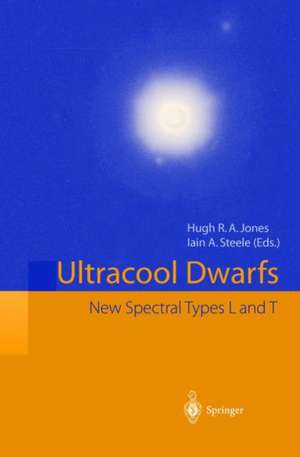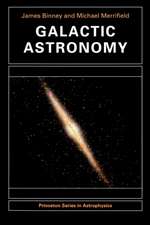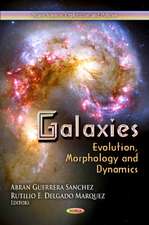Ultracool Dwarfs: New Spectral Types L and T
Editat de Hugh R.A. Jones, Iain A. Steeleen Limba Engleză Hardback – 10 sep 2001
| Toate formatele și edițiile | Preț | Express |
|---|---|---|
| Paperback (1) | 636.12 lei 43-57 zile | |
| Springer Berlin, Heidelberg – 6 noi 2012 | 636.12 lei 43-57 zile | |
| Hardback (1) | 642.18 lei 43-57 zile | |
| Springer Berlin, Heidelberg – 10 sep 2001 | 642.18 lei 43-57 zile |
Preț: 642.18 lei
Preț vechi: 755.51 lei
-15% Nou
Puncte Express: 963
Preț estimativ în valută:
122.88€ • 128.62$ • 102.28£
122.88€ • 128.62$ • 102.28£
Carte tipărită la comandă
Livrare economică 31 martie-14 aprilie
Preluare comenzi: 021 569.72.76
Specificații
ISBN-13: 9783540423539
ISBN-10: 3540423532
Pagini: 208
Ilustrații: VIII, 197 p.
Dimensiuni: 155 x 235 x 17 mm
Greutate: 0.47 kg
Ediția:2001
Editura: Springer Berlin, Heidelberg
Colecția Springer
Locul publicării:Berlin, Heidelberg, Germany
ISBN-10: 3540423532
Pagini: 208
Ilustrații: VIII, 197 p.
Dimensiuni: 155 x 235 x 17 mm
Greutate: 0.47 kg
Ediția:2001
Editura: Springer Berlin, Heidelberg
Colecția Springer
Locul publicării:Berlin, Heidelberg, Germany
Public țintă
ResearchDescriere
Once you have looked at the night sky on a moonless night it is not hard to realise why so much of our science and religion has its roots in the stars. Yet it took until 1850 to realise that fainter stars were not necessarily further away, nor the brighter ones closer. In fact within the magnitude range observable to the naked eye it is probable that the brighter star is in fact further away. Even today the measurement of stellar distances is relatively difficult and is gener ally only done using dedicated telescopes. In the early years of the 20th century Hertzsprung and Russell developed a powerful classification diagram which al lows stars to be distinguished using a plot of their colour versus magnitude. The construction of this diagram involved the use of spectroscopy which has become the cornerstone of modern astronomy. As telescopes become more powerful, de tectors more sensitive and more physics is added to astrophysics, astronomical spectroscopy becomes a more powerful tool. The concern of this book is the spectral classification of stars. With a single spectrum of a star it is possible to uniquely classify an object and find its place on the Hertzsprung-Russell diagram. This spectrum is thus equivalent to having the colour and the magnitude of the object which can in turn be related to mass and other quantities.
Cuprins
I Theory.- Introduction: Theoretical Models of Brown Dwarfs — an Observer’s Perspective.- Unified Model Photospheres for Ultracool Dwarfs of Types L and T.- Alkali Metals and the Colour of Brown Dwarfs.- Formation of the Optical Spectra of L Dwarfs.- II Observations.- Introduction: The Coolest Dwarfs — a Brief History.- Imaging and Spectroscopy of Hot (Young) “Ultracool” Companions.- Activity and Kinematics of M and L Dwarfs.- Infrared Spectroscopy of Brown Dwarfs: the Onset of CH4 Absorption in L Dwarfs and the L/T Transition.- Surface Features, Rotation and Atmospheric Variability of Ultra Cool Dwarfs.- Low-Mass Stellar and Brown Dwarf Binary Systems.- The Second Guide Star Catalogue and Cool Stars.- Low-Luminosity Companions to Nearby Stars: Status of the 2MASS Data Search.- III Spectral Classification.- Introduction: The Spectral Types of the Ultracool Dwarfs.- The Classification of L Dwarfs.- Spectroscopy of Young Brown Dwarfs and Isolated Planetary Mass Objects.- The Classification of T Dwarfs.- L-Band Photometry and Spectroscopy of L and T Dwarfs: Exploring Infrared Spectral Typing.
Textul de pe ultima copertă
This book records our current understanding of the observational and theoretical properties of objects known as ultracool dwarfs. It covers the state of the art in this new field. It is split into theoretical, observational and spectral classification sections. Each subject area begins with an introduction by an eminent scientist. It covers a wide range of issues, such as the transition from L to T dwarfs, dust and alkali metal modelling, companions, activity, the deuterium test, and brown dwarf variability, and contains considerable discussion about spectral classification schemes. The articles arose from an IAU meeting and they address researchers as well as graduate students.
Caracteristici
Includes supplementary material: sn.pub/extras












